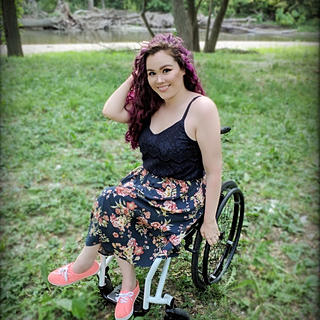After Years of Battle, A Monster Unveiled
- Monica Thomas
- Jun 26, 2018
- 3 min read

My phone buzzed on my desk at 5:30 on Friday evening. I didn't recognize the number and bet my coworkers that it was one of the many spam calls we all get on a daily basis. I fought my natural instinct and picked up. It was my neurologist. The results of my genetic test were in, and he was ready to go over them with me.
For two decades I've been fighting a monster shrouded in shadow. Its basic shape was visible, its ability to deal damage clear, but I was always unable to see its next move, to anticipate its next blow. And now, mere weeks after my nerves had been thoroughly shocked and I had spit into a plastic tube, the monster was going to reveal itself.
My hand poised over a yellow legal pad, I waited for the words that would confirm a lifetime of struggle.
"You have Type 2A."
There it was. In three seconds, my biggest question about my body and medical history had been answered. CMT Type 1A, the most common type and the one some of my family members are suspected to have, affects the myelin sheath covering the nerve. CMT Type 2A damages the nerve directly, which is why my progression was so swift. My monster was unveiled.
Holding back unexpected emotion, I excused myself to the break room to call my mom. I told her everything the neurologist had told me, rejoicing that my progression wasn't the result of laziness. No matter how much physical therapy I did, my nerves were damaged and they weren't coming back. It was almost freeing.
"I don't want you to stop fighting," she said to me when I had finished, her concern obvious.
"Never." My fight has raged on for two decades and will continue. The difference is that now, I can see my opponent.
I spent the next 30 minutes at work researching CMT Type 2A. It was like reading a checklist of my life.
Early-onset CMT2A patients usually experience severe symptoms that begin before age 10.
Check.
Postural tremors are common.
Check.
Decreased motor nerve conduction velocity.
Check. (Mine was undetectable.)
Musculoskeletal pain.
Check.
I saw a couple of symptoms that terrified me. Atrophy of the optic nerve and vocal chords are common in those with early-onset 2A. My eyesight and voice are normal now, but I can't help but wonder if the monster has those blows to my nerves in its arsenal, locked and loaded.
I have an appointment with my neurologist and a genetic counselor to go over the full report in September. My lifetime of struggle will be scientifically displayed on three sheets of paper. I don't know if they'll be able to see what's in store for me, if the facts and figures will tell of a future of poor eyesight and a hoarse voice. My mom asked me if I even want to know. She's not sure that she would.
But I do. I want to know because I soak up information like a sponge, and this information, about my own future, is the juiciest I can imagine. But more than that, when you know the bad stuff in life, it forces you to appreciate the good. In the same way that death forces us to appreciate life, the knowledge that my eyesight might deteriorate may force me to look at everything, to really soak in the beauty of the world; the knowledge I could one day lose some of my voice may force me to speak up while I can. This isn't a given, of course. My eyes and voice could remain totally unaffected, as they have so far. And yes, we should always strive to look around and speak up anyway. But loss is the ultimate motivator. That's just universal human truth.
My biggest hope is that I'll be able to participate in clinical trials to advance the search for a cure (most trials are type-specific). Unless science advances at a science-fiction rate, the damage to my nerves will remain irreversible, even if a cure is discovered. The monster has dealt its damage and left me shattered beyond repair. But unveiling my own monster may just help slay the others that are out there, and that is worth the cost of going into battle.
Do you or someone you know have CMT Type 2A? Let me know in the comments!








Comments